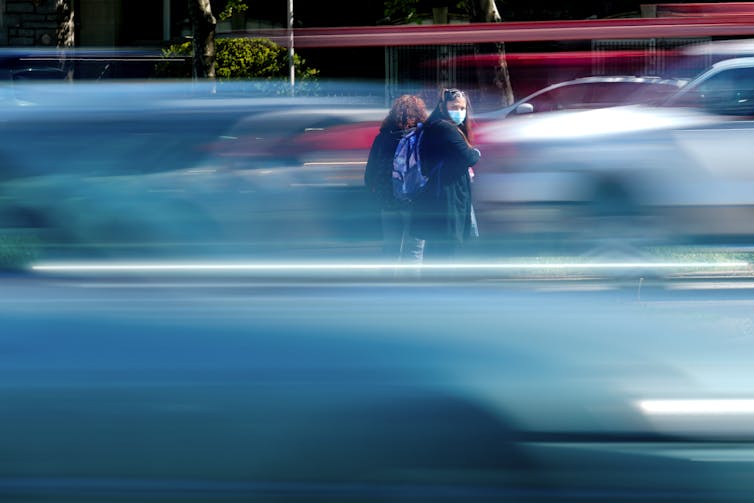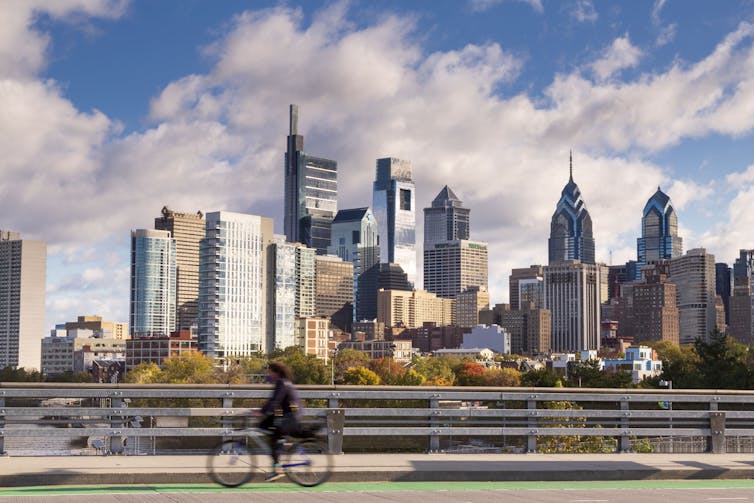Over 60 pedestrians and cyclists have been killed each year in Philadelphia in recent years.
Compared with other big cities, Philadelphia’s death rate for both pedestrians and cyclists is higher than New York and Chicago but lower than Los Angeles and Houston.
Across the U.S., more pedestrians and bicyclists are killed or seriously injured today than any time over the past 40 years. Over 7,500 pedestrians and over 1,100 bicyclists died in traffic collisions in 2022, the most recent year with available data, according to the National Highway Traffic Safety Administration.
As an injury epidemiologist in Philadelphia who studies pedestrian and bicyclist injuries in the U.S. and Latin America, I want to share several evidence-based ways that Philadelphia can make walking, biking and getting around the city safer for everyone.
Protect bike lanes
Protected bike lanes have physical barriers that prevent drivers from entering the bike lane to park or pass other drivers.
They are particularly useful on high-volume cycling corridors and offer cyclists much more protection than lanes that are merely painted but have no physical barriers or lanes with flexible posts that can be driven over.
Flexible posts, for example, were unable to block the collision that killed Barbara Friedes, chief pediatric resident at Children’s Hospital of Philadelphia, in Center City in July 2024 when a drunk driver sped through the bike lane where Friedes was bicycling.
Research suggests protected bike lanes can improve safety for pedestrians and drivers too. This is likely because they tend to cause drivers to slow down.
The Bicycle Coalition of Greater Philadelphia and other local bike safety advocacy groups have called for the city to replace unprotected lanes with protected lanes and also add protected bike lanes to more roadways that currently don’t have any.
In October 2024, the city announced it will install concrete barriers to protect the bike lanes on Spruce and Pine streets in Center City, including where Friedes was killed. That same month, the City Council unanimously passed a “Get Out the Bike Lane” bill that increases the fines for drivers who stop or park in a bike lane.

Matt Rourke/AP
Slow drivers down
Traffic-calming measures are engineering and road design strategies that slow vehicles down, make pedestrians more visible to motorists and provide safer crossing areas.
They include speed humps, curb extensions and protected intersections, as well as 20 mph speed zones.
Automated speed enforcement, which involves cameras that capture the license plates of drivers who are speeding, has led to major reductions in speeding and serious collisions on Roosevelt Boulevard. The street, which runs through North and northeast Philadelphia, has been named one of most dangerous roads in the country in various analyses by news and transportation organizations. Due to this success, the city plans to expand automated speed enforcement to Broad Street in 2025 and potentially other locations in the future.
Traffic-calming measures can benefit all road users by reducing traffic congestion so drivers and public transit riders face fewer delays. They can also boost nearby businesses by increasing foot traffic and making business corridors more pleasant for shoppers.
Encourage fewer cars on the road
Philadelphia can adopt more policies that promote walking or biking over driving. These include open streets or ciclovías, where streets are closed down to motor vehicle traffic and opened to cyclists and pedestrians. Philadelphia occasionally does this on stretches of 18th Street and Walnut Street in Center City.
Increasing parking fees can also reduce traffic congestion. Parking fees generally do not reflect the true cost of driving in cities, which include maintaining parking spaces and infrastructure. The low cost of parking is essentially a subsidy to drivers. While there are fears that reduced parking hurts business owners, substantial evidence indicates businesses benefit from increased foot and bicycle traffic.
The city could also reduce the number of parking spaces and implement congestion pricing, which involves charging fees to drive in certain areas of a city to reduce traffic congestion.
This may be a challenge, considering the recent experience of New York City, which spent decades preparing for congestion pricing only to have it blocked by the governor, though it seems it now has a chance of being implemented. How much success New York has with congestion pricing will likely determine the feasibility in Philadelphia and other U.S. cities.

Jumping Rocks/UCG/Universal Images Group via Getty Images
Improve public transportation
Expanding public transportation and lowering or eliminating fares can also help protect pedestrians and cyclists by reducing car use. I believe these measures could help ensure the other policies mentioned above are effective.
However, Philadelphia’s public transportation is currently in a critical state. Facing funding shortfalls due to years of declining ridership, the Southeastern Pennsylvania Transportation Authority has proposed service cuts and significant fare increases beginning Jan. 1, 2025. Gov. Josh Shapiro has spared the system from these cuts for now by flexing federal highway funds, but long-term solutions are needed to ensure the survival and revival of public transportation in Philadelphia.
Addressing gun violence, drug use and other crimes may also make public transportation in Philadelphia safer and more attractive. While violent crimes on Philadelphia’s public transportation have dropped dramatically in 2024, four people have lost their lives on SEPTA vehicles so far this year.
Collect better data
Considering the increase in road traffic deaths in Philly since the start of the COVID-19 pandemic, substantial efforts are needed to reach the city’s Vision Zero goal of reducing road traffic deaths to zero by 2030.
In my view, this includes better data on transportation use and which interventions and policies are working and which are not.
Road safety surveillance could be improved in Philadelphia and across Pennsylvania by linking crash records to other data, such as hospital and clinical data of crash victims, as well as insurance costs to better understand the burden of road traffic injuries on the city and the state.
Data is also key to ensuring public policies are implemented equitably. The Vision Zero plan includes a focus on lower-income neighborhoods and those with higher proportions of racial and ethnic minorities. Those areas have three times as many serious injuries and deaths as other neighborhoods, and road traffic injury and deaths rates are 30% higher among people of color compared with white residents.



